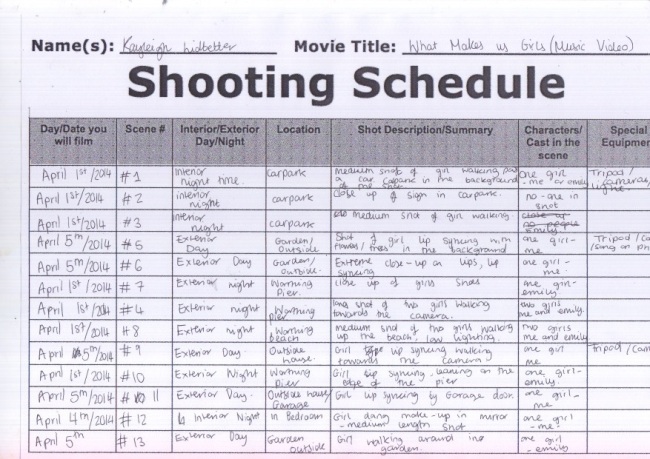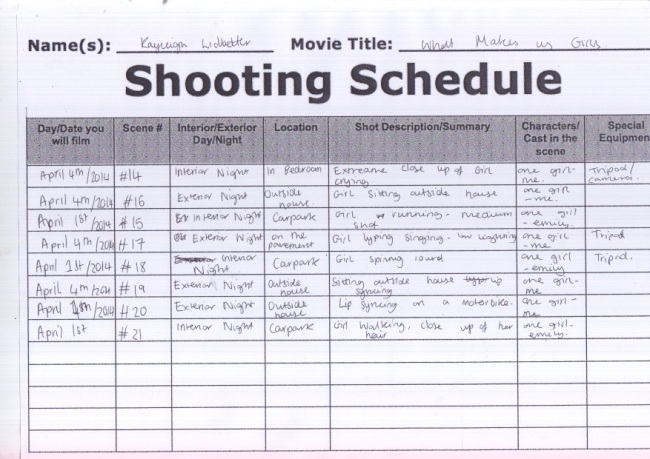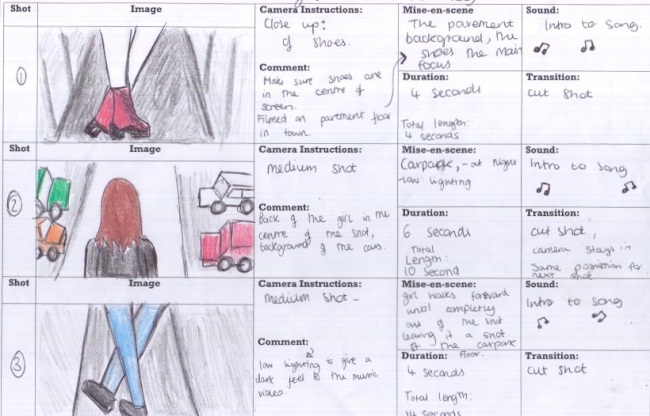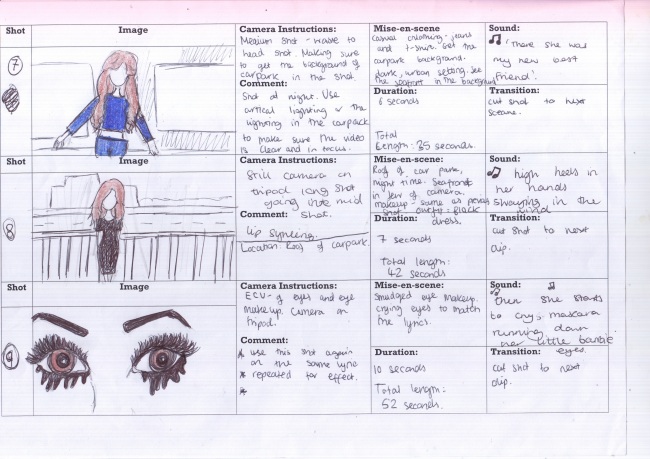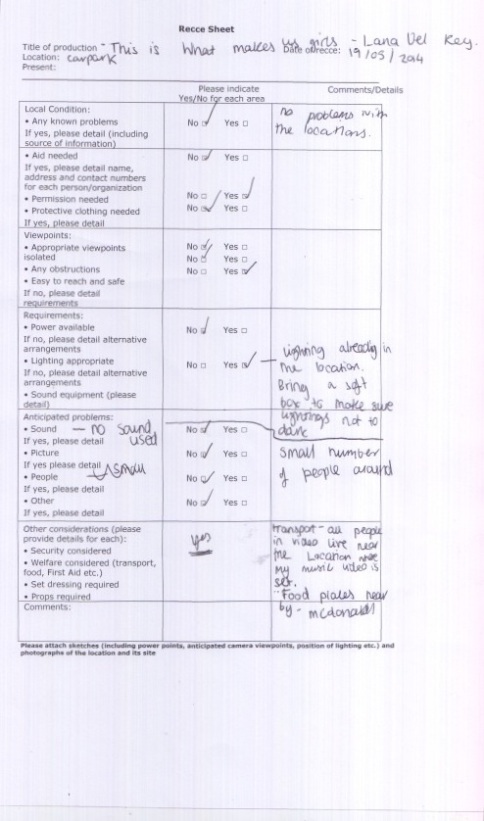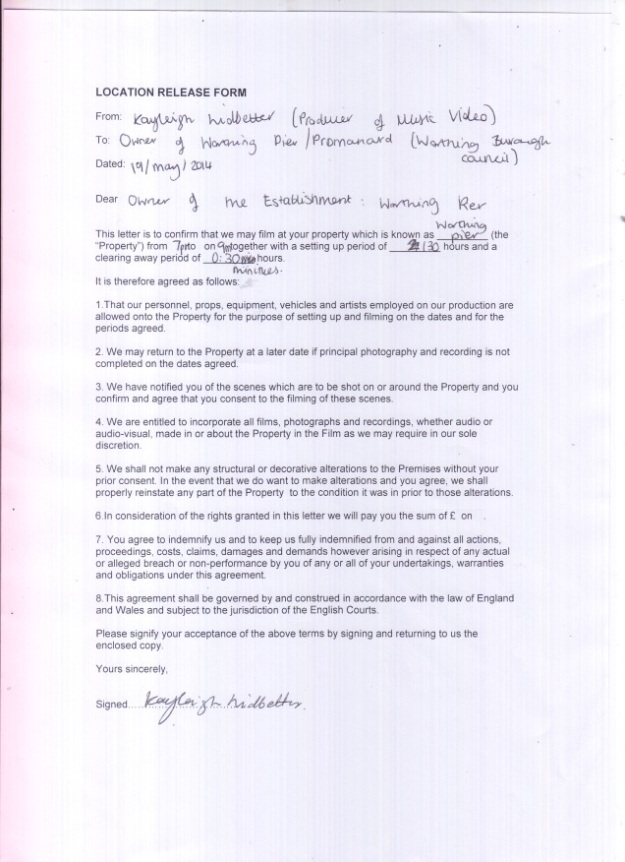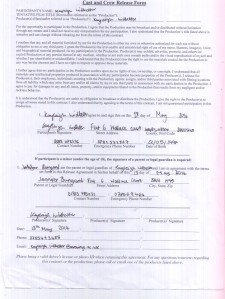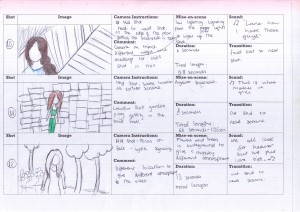Music Video-Preproduction Storyboards
Music Video Pre Production-Cast and Crew Release Forms
Music Video Pre-Production-Reece Sheet
Music Video Pre-Production -Location Release Form
Music Video-Pitch
Song: What makes us girls
Artist: Lana Del Rey
I gained inspiration for my music video by listening to the lyrics and thinking of ideas which would relate to the tone and mood of the song.I decided that i want to use low lighting to set the mood contrasting with brighter lighting on the chorus.
I want to use varied camera shots in my music video, one of my ideas is to use close-ups the girls eyes and shoes as shes walking.i will have long shots setting the scene and of people and then i will change that to a medium shot of them.Locations i am going to use in my video are the pier at night so so the lights on the pier will bring light to the shot.Other locations i am thinking of using are the the car park and also my garden.

Music Video -Re uploaded
Single Camera Production Techniques
Single Camera setup is a method of filmmaking and production.Each of the various shots and camera angles is taken by using the same camera , moved to each new shot and angle. Alternative production method, which is more widely used is still called a “single-camera”, but in actuality two cameras are employed – one to capture a medium shot of the scene while the other to capture a close-up during the same take, which saves time as there are half as many set-ups for each scene.The lighting setup is typically reconfigured for each camera setup.Advantages of using single camera setup is that it gives the director more control over each shot.The single-camera setup originally developed during the birth of the classical Hollywood cinema in the 1910s and has remained the standard mode of production in the cinema. In television, both single camera and multiple-camera productions are common. Television producers make a distinct decision to shoot in single-camera or multiple-camera modes—unlike film producers who almost always opt for single-camera shooting. In television, single-camera is mostly reserved for prime-time dramas, made-for-TV movies, music videos and commercial advertisements.
Multi Camera production is a multiple-camera mode of production, multi-camera or simply multicam is a method of filmmaking and video production. Several cameras (film or professional video cameras) are employed on the set and simultaneously record or broadcast a scene.Generally, the two outer cameras shoot close-up shots of the two most active characters on the set at any given time, while the central camera or cameras shoot a wider master shot to capture the overall action and establish the geography of the room. In this way, multiple shots are obtained in a single take without having to start and stop the action. This is more efficient for programs that are to be shown a short time after being shot as it reduces the time spent film editing or video editing the footage.Multi Camera set-up is needed for high output shoes like soap operas( e.g Eastenders).Advantages are that scenes may be shot far more quickly as there is no need for re-lighting and the set-up of alternative camera angles for the scene to be shot again from the different angle. It also reduces the complexity of tracking continuity issues that crop up when the scene is reshot from the different angles. It is an essential part of live television: used for studio based shows such as This Morning and Jeremy Kyle also for live events such as sports and live festival/concerts.
One example of a single camera production is feature films.Single camera technique is used in feature films.
The narrative structures include multi strand narrative and single strand narrative.An example of a multi store narative is soaps such as Eastenders.Eastenders has a multi strand narrative which follows many characters story lines and cuts between character scenes. As Eastenders has a multi strand narrative which follows many character storylines and cuts between scenes each episode manly focuses on one main character and there story line cutting to other minor characters and then other main characters that play a part I that story line. Soaps usually build up their story line’s to a climax where there is a feature episode, which is longer than other episodes and unresolved issues become resolved. Single strand narrative structures is when the plot is focused on one main protagonist and his story.The advantages of a single strand narrative is that it helps the audience to focus on one character and his story. The disadvantages of a single strand narrative is that the story would be boring because other factors are not involved to the build up of the story.One example of a single strand narrative is Sherlock as it focuses on one main protagonist.
A narative can be linier and non linier.Linear or sequential narratives are when stories flow in a chronological order with a start, middle and end. The products include no flashbacks or dream sequences. Everything happens in present time order.Soap Operas have three types of characters-Main characters, minor characters, extras.An example of a linear media product is Coronation Street. This is because it continues its plots in a chronological order.A non linier narrative structures are when stories do not follow a chronalogical order and the plot is distorted due to time (past, present and future). These kind of products usually include effects such as flash-backs and reverse narrative.An example of a non-linear narrative is the film Inception. This is because it uses a lot of flashbacks and dream sequences to make up the story of the film.
CAMERA SHOTS:
An extreme long shot contains a large amount of landscape. It is often used at the beginning of a scene or a film to establish general location (setting). This is also known as an establishing shot.A long shot (animation on right) contains landscape but gives the viewer a more specific idea of setting. A long shot may show the viewers the building where the action will take place.
A full shot (animation on right) contains a complete view of the characters. From this shot, viewers can take in the costumes of characters and may also help to demonstrate the relationships between characters. For more information on costumes and acting refer to Chapter 4.
A mid shot (animation on right) contains the characters or a character from the waist up. From this shot, viewers can see the characters’ faces more clearly as well as their interaction with other characters. This is also known as a social shot
A close-up contains just one character’s face. This enables viewers to understand the actor’s emotions and also allows them to feel empathy for the character. This is also known as a personal shot.
An extreme close-up contains one part of a character’s face or other object. This technique is quite common in horror films, particularly the example above. This type of shot creates an intense mood and provides interaction between the audience and the viewer.
CAMERA ANGLES
A bird’s eye angle is an angle that looks directly down upon a scene. This angle is often used as an establishing angle, along with an extreme long shot, to establish setting.
A high angle is a camera angle that looks down upon a subject. A character shot with a high angle will look vulnerable or small. These angles are often used to demonstrate to the audience a perspective of a particular character. The example above demonstrates to us the perspective or point of view of a vampire. As a viewer we can understand that the vampire feels powerful.
An eye-level angle puts the audience on an equal footing with the character/s. This is the most commonly used angle in most films as it allows the viewers to feel comfortable with the characters.
A low angle is a camera angle that looks up at a character. This is the opposite of a high angle and makes a character look more powerful. This can make the audience feel vulnerable and small by looking up at the character. This can help the responder feel empathy if they are viewing the frame from another character’s point of view.
Camera movement
A crane shot is often used by composers of films to signify the end of a film or scene. The effect is achieved by the camera being put on a crane that can move upwards
A tracking shot and a dolly shot have the same effect. A tracking shot moves on tracks and a dolly shot is mounted on a trolley to achieve the effect in the example above. This camera movement is used in a number of ways but is most commonly used to explore a room such as a restaurant. By using a tracking shot or a dolly shot the composer of a film gives the viewer a detailed tour of a situation. It can also be used to follow a character.
Panning is used to give the viewer a panoramic view of a set or setting. This can be used to establish a scene.
Lighting is a very important aspect for shaping meaning in films and TV.In soap opera’s (Eastenders) the lighting used in the programme tends to be natural lighting. This gives the effect that no artificial lighting is used to give it a realistic feel as the aim of the programme is to be true to live and relatable.Compared to feature films which tend to use articifal lighting.
Diagetic sound is sound that comes from a source visable on screen implied to be present by the action of the film.
-voices of characters
-sounds made by objects in the story
-music represented as coming from instruments in the story space
Diegetic sound is any sound presented as originated from source within the film’s world
Digetic sound can be either on screen or off screen depending on whatever its source is within the frame or outside the frame.
Non diagetic sound is sound that Sound whose source is neither visible on the screen nor has been implied to be present in the action:
narrator’s commentary
sound effects which is added for the dramatic effect
mood music
Non-diegetic sound is represented as coming from the a source outside story space.
